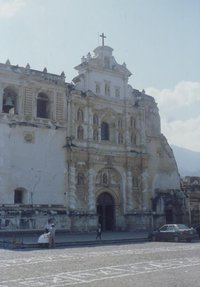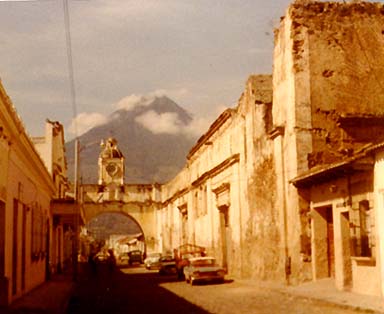Antigua Guatemala
|
|
Antigua Guatemala (commonly referred to as just Antigua or La Antigua) is a city in the central mountains of Guatemala famous for its well-preserved Spanish New World Baroque architecture as well as a number of spectacular ruined churches. It has been designated a UNESCO World Heritage Site.
| Contents |
Population
The city had a peak population of some 60,000 in the 1770s; the bulk of the population moved away in the late 18th century. Despite significant population growth in the late 20th century, the city reached half that number in the 1990s. According 2000 census, the city has some 31,800 inhabitants.
History
Antigua Guatemala means the "old city of Guatemala". It was founded on March 10, 1543. and served as Spanish colonial capital of Central America. The conquistadores named the city La Muy Noble Y Muy Leal Ciudad de Santiago de los Caballeros de Guatemala ("The Very Noble and Very Loyal City of Santiago of the Knights of Guatemala"), in honor of their patron saint, Santiago, or St. James.
In 1773, it suffered two severe earthquakes, which destroyed much of the town. The Spanish Crown ordered the city rebuilt at a safer location, where what is now Guatemala City, the modern capital of Guatemala. In 1776 the badly damaged city was ordered abandoned, although not everyone left.
Antigua today
Nowadays, Antigua is noted for its very elaborate religious celebrations for the Holy Week leading up to Easter.
There are also many Spanish language schools in the Antigua; it is one of the most popular places in Latin America to study Spanish.
Antigua is the capital of the department of Sacatepéquez.
Volcanos
Three large volcanos dominate the horizon around Antigua.
The most commanding, to the south of the city, is the Volcán de Agua or "Volcano of Water", some 3766 meters high. It is so named because the crater atop it was formerly filled with water. Shortly after the Spanish conquest of Guatemala, the first capital was on a site part way up this mountain, which was destroyed by a flood and mudslide when an earthquake let loose the water from the crater, and the city of Guatemala was moved down the valley to the current Antigua. The original site is a village now known as Ciudad Vieja.
To the west of the city are a pair of peaks, Acatenango, long inactive, some 3976 meters high, and the Volcán de Fuego or "Volcano of Fire", some 3763 meters high. "Fuego" is famous for being almost constantly active at a low level. Smoke issues from its top daily, but larger eruptions are rare.
Photos
Missing image
Antigua1.JPG
Image:Antigua1.JPG
Street with Volcán de Agua in distance

Homestead in ruins of a colonial Spanish building; Volcánes de Fuego (left) and Acatenango visible in distance
Missing image
Antigua4.JPG
Image:Antigua4.JPG
A colonial church facade
Arch connecting two parts of old Convent, Volcán de Agua in background
External links
- enantigua.com (http://www.enantigua.com) Text in Spanish; many good photos
- Map on infovia.com (http://www.infovia.com.gt/antiguaguatemala/Mapa2.htm)
- photos on eveandersson.com (http://eveandersson.com/guatemala/antigua)de:Antigua Guatemala
es:Antigua Guatemala it:Antigua (città) nl:Antigua Guatemala



